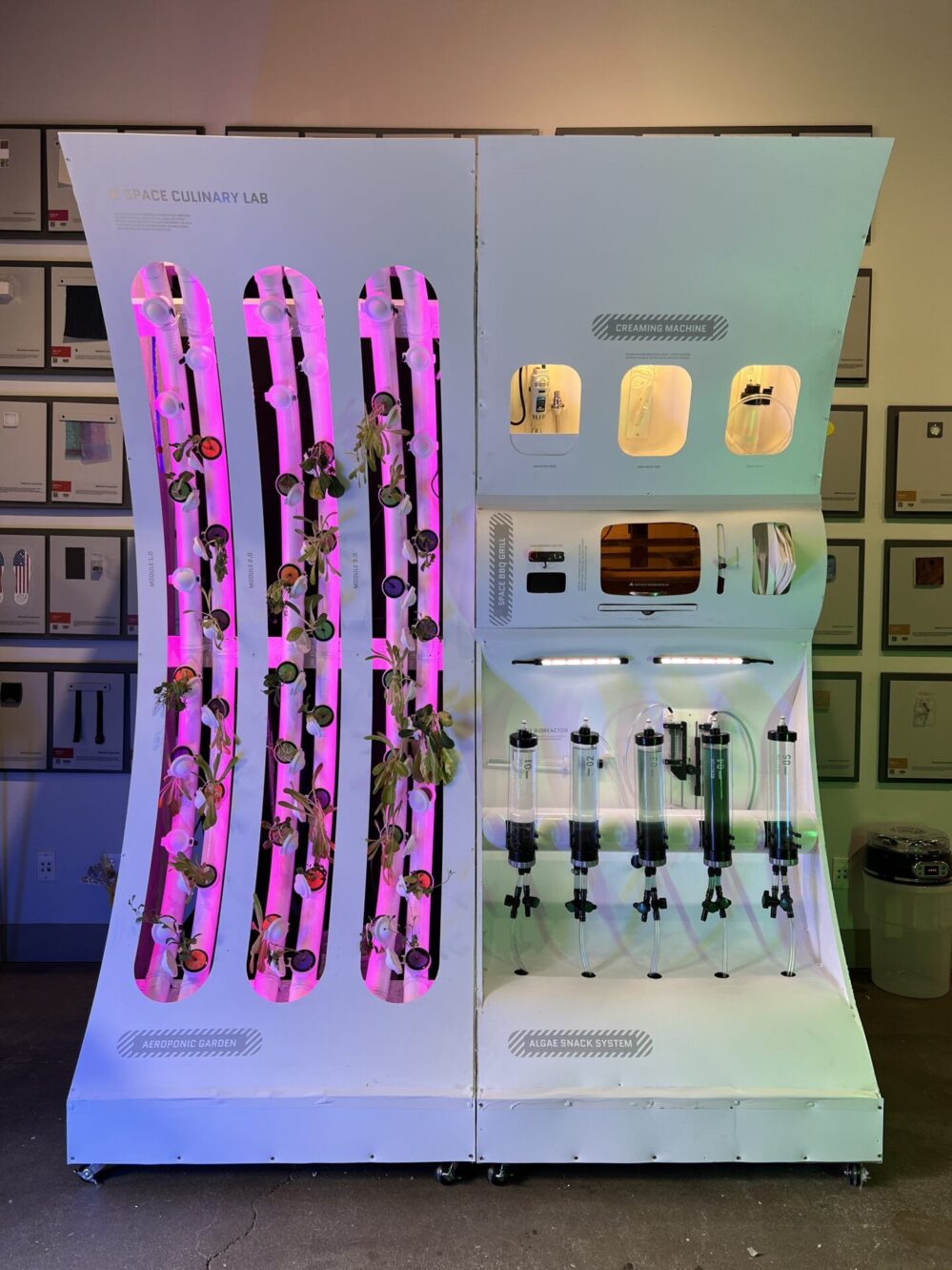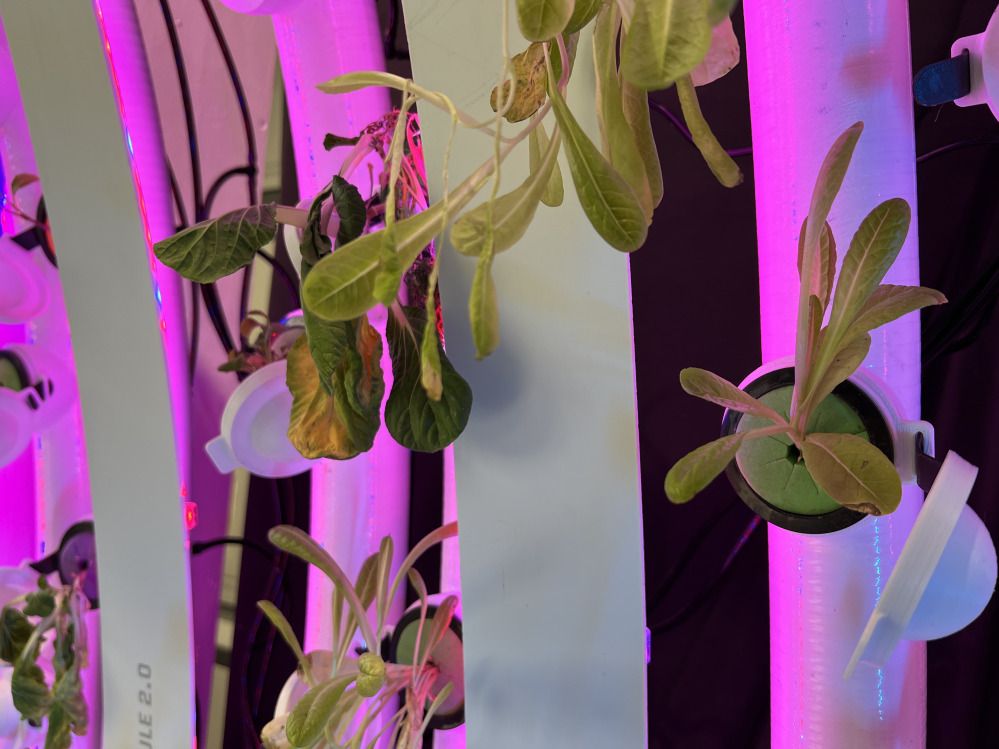If you’re in space for three days, says Phnam Bagley, food is fuel. If you’re on a three-year round trip to Mars, it’s mission critical, a matter of life and death.
“When we think about short-term missions, we tend to think about things like rocketry, training, and maintenance. Food is at best an afterthought,” says Bagley, founding partner and creative director at design firm Nonfiction, which has been working on the mechanics of producing food on a mission to Mars after entering a competition (the Deep Space Food Challenge) launched by NASA and the Canadian Space Agency in 2021.
Professional astronauts, who are often ex-military, generally eat what they’re given and move on with the task at hand, adds Bagley, an industrial designer specializing in space architecture. “Which is absolutely fine for a few days or even a couple of months… but it’s not going to fly if you’re going to Mars.”
Put another way, she says, if you’re spending two-and-a-half to three years in microgravity in a metal box, “food is more than just sustenance at this point. It is about pleasure… it’s really the basis of culture and a way to relate to the space you live in and the people you live and work with.”
So what will astronauts eat on a mission to the red planet?
The Deep Space Food Challenge—coordinated by the Methuselah Foundation—was designed to identify food production technologies that can:
- Help fill food gaps for a crew of four for a three-year round-trip with no resupply
- Improve the accessibility of food on Earth, via production in urban centers or extreme environments
- Achieve the greatest amount of food output with minimal inputs and minimal waste
- Create a variety of palatable, nutritious, and safe foods requiring minimal processing time
AgFunder News (AFN) caught up with Bagley (PF) to talk about Nonfiction’s entry to the challenge: The Space Culinary Lab, a compact, low-maintenance lab designed to make it fun and easy for astronauts to grow and prepare food. It has four key components:
- Microalgae-fueled snacks: Nutrient-rich microalgae that can be harvested and combined with dry ingredients to make bite-sized snacks.
- Laser-grilled meat and veggies: Open flames are not an option in space. But if you slide rehydrated chicken between two glass plates and fire lasers at it, you get a flame-grilled look and taste.
- Emulsion system for creamy drinks, desserts, sauces: An emulsion system powered by an ultrasonic homogenizer enables astronauts to make freshly whipped products by putting a surgical steel probe into a reusable bag containing a mix of water and oil-based ingredients.
- Aeroponically grown microgreens: Salad greens grown in rockwool.
AFN: What is the Space Culinary Lab designed to do beyond simply fueling astronauts?
PB: Having a sense of agency is really what I want to bring astronauts, to make preparing and eating food a fun activity. And fun is really important because astronauts that are in space for a number of months tend to lose the pleasure of eating. They eat for sustenance, and they start losing weight.
If you lose a couple pounds when you’re in orbit around the Earth, it’s not that big of a deal. When you’re losing weight millions of miles away from the Earth [on a mission to Mars], that’s a life and death situation. So about 600 astronauts have been up in space and only two or three of them came back heavier than when they left; everyone else lost weight and that’s actually very dangerous.
So that’s part of the reason we included the emulsifying system, as it’s really pleasurable to experience creamy textures; a creamy latte is more satisfying than [plain] coffee.
AFN: What constraints apply when you’re designing food systems that will work on a spaceship?
PB: My background is in industrial design, but also space architecture. I actually went to school for that almost 20 years ago, designing for extreme environments, including astronauts’ environments.
There are multiple constraints, including volume and water use. So on the International Space Station, for example, there’s a system that allows for water to be recycled with 90% efficiency, which is critical, because weight in space is money, and water is heavy.
So, whatever water system we’re using in our Space Culinary Lab, whether for watering the aeroponic system [for growing leafy greens] or letting the microalgae [for nutrient-rich snacks] grow in the bioreactor, we had to make sure that it was not contaminated with potent microbes to the point where we couldn’t recycle it again.
Energy is another constraint. So that is going to come from multiple sources when you go to Mars, some solar, some nuclear, and some other types of energy such as fuel cells, so we have to take that into account.
Lighting is also something we have to think about, so there are different wavelengths of light that make food such as algae and the plants we’re growing aeroponically grow faster or slower.
And finally, we also have to think about microgravity [low gravity], and how to move one volume of liquids or solids from one place to the other without causing an explosion of food that will float around.
This also impacts the types of foods we can offer. Take bread, which we take for granted on Earth. That can create crumbs, and crumbs are dangerous, because they can do things like clog up air filtration systems.

AFN: How did the concept of the Space Culinary Lab evolve over time?
PB: Phase one of the Deep Space Food Challenge was really about presenting concepts, whereas for phase two we had to create a functional prototype and also show our food was safe to eat. So you start with a bunch of assumptions, and then you build the thing, put living things in it, and then figure out why they don’t live, as microalgae can be very fragile.
Same thing with aeroponics. Our first design [for growing fresh leafy greens] used hydroponics [immersing the roots in water], but we soon realized that it utilized too much water and that water could leak anywhere.
So we decided to use aeroponics instead, which uses the bare minimum when it comes to water and the water is mainly nutrients, which these are sprayed on top of the enclosed roots, which grow in rockwool [a light, sterile, porous material made from basaltic rock].
The other good thing about rockwool is that you can separate it from the plant when you harvest it, and then you can microwave it and re-use it for the next batch.

AFN: The Space Culinary Lab combines ingredients grown on the ship with pre-packaged foods. What are the criteria for pre-packaged foods for a long-haul mission?
PB: So obviously, they have to be shelf stable for up to three years, and we also try to separate ingredients as much as possible for two reasons. One, because when you combine oils and dry things they tend to break down faster; and two, if we separate ingredients, astronauts can customize their foods, to make their algae snacks sweet, or savory, for example.
Weight is critical, so everything is dehydrated, and if we want to use powders, we usually compact them. With proteins, we dehydrate them; that’s a system NASA has been using for a long time, same in the military.

AFN: How does working on space food impact the food system on Earth?
PB: This has to go beyond just feeding astronauts. Most people haven’t been in space and are not going there anytime soon. But there are places on this planet that are becoming more and more like extreme environments due to limited resources, whether it’s water or energy or labor, so we have to think about how to create nutritious beautiful food in these places, whether it’s in refugee camps or food deserts in the middle of cities.
AFN: Isn’t it likely that on the first Mars mission, that food will be sent to Mars in advance?
PB: Yes, that’s absolutely what’s going to happen in the first few missions.
AFN: What if your growing systems fail?
PB: We’re making the assumption that what grows in low Earth orbit will grow on the surface of Mars and on the way to Mars, and that’s not necessarily the case. We can’t risk starving astronauts because we haven’t taken into account a radiation type that might compromise the growth of certain foods, for example.
You always have to have a plan B and a plan C. Once we have proven that aeroponics work under these conditions, or that we can grow microalgae consistently on several Mars missions, then they will slow down plan B and plan C.
There are also discussions about whether we can grow things on the surface of Mars or the Moon, as we have to think about what we’re going to feed the people who might work there for six months at a time. Thinking about how we do it on Mars is going to help figure out how we’re going to do on the Moon and vice versa.
AFN: So how did you do in the Deep Space Food Challenge?
PB: We were one of the prize winners in phase one, but we didn’t make it into phase two, but for us it’s an ongoing project.
We’re designers, not food scientists, and if we’re thinking about the future of the space economy, where people like you and me are going to go into space for tourism or work, much the same way that we using airplanes today to get from point A to point B, we have to think more about the marriage between function, value and aesthetics.
How do we elevate food, rest, and personal space?
Read more HERE about the Deep Space Challenge.




